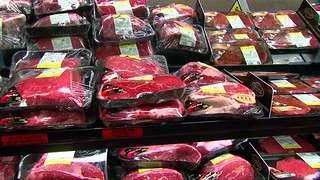K-State food safety expert shares do’s and don’ts to ensure you and your family are safe
MANHATTAN, Kan. – You may have learned from parents or grandparents, or even read in old recipes, to rinse meat before cooking. But Kansas State University food scientist Karen Blakeslee said rinsing meat is an outdated practice that can create food safety problems.
“This can lead to foodborne illness,” Blakeslee said. “Rinsing meat at home can lead to cross contamination of clean surfaces or ready-to-eat foods, as examples.”
Any meat bought from the store is already rinsed during processing, she said, so it can be immediately prepped and cooked without any rinsing step at home.
To be safe at home, other food safety practices are important, according to Blakeslee. Before handling any food, and especially after handling raw meats, washing your hands with soap and water for 20 seconds is a vital first step in safe food preparation.
“Be sure equipment and surfaces are clean before and after preparation,” Blakeslee said. “Never reuse any raw meat and poultry packaging materials, such as foam meat trays or plastic wraps.”
When shopping at the grocery store, place raw meats in plastic bags and place in the bottom of the cart. At home, store the meat packages on the bottom shelf of the refrigerator, on a plate or tray, so juices or liquids do not seep out and spill onto other foods.
Blakeslee also said that cooking food to the correct internal temperature is one of the most important factors in ensuring your food is safe. Cooking to these temperatures kills any harmful bacteria still left on the food. The minimum recommended temperatures are.:
• 145 degrees Fahrenheit for all beef, pork, lamb and veal steaks, roasts and chops.
• 145 F for fish and seafood.
• 160 F for ground meat.
• 165 F for all forms of poultry.
Blakeslee added a meat’s “doneness” can never be judged by its color or appearance.
“For example, cooked ground beef may look pink in the middle, but when checked with a thermometer it may be at or above the safe temperature of 160 degrees Fahrenheit,” she said.
Blakeslee recommends using a food thermometer to check a product’s internal temperature and ensure safe food.
For more information on food safety during the holidays, Blakeslee recommends the Holidays section of the K-State Research and Extension food safety website or K-State’s publication, At-Home Safe Food Handling: It’s in Your Hands.
Blakeslee publishes a monthly newsletter called You Asked It! that provides numerous tips on being safe and healthy. More information is also available from local extension offices in Kansas.
-30-
FOR PRINT PUBLICATIONS: Links used in this story
Food Safety for Holiday Meals (website), www.ksre.k-state.edu/foodsafety/topics/holiday.html
At-Home Safe Food Handling: It’s in Your Hands (publication), https://bookstore.ksre.ksu.edu/pubs/MF2465.pdf
You Asked It! (newsletter), www.rrc.k-state.edu/newsletter
K-State Research and Extension statewide offices, https://www.ksre.k-state.edu/about/statewide-locations.html
K-State Research and Extension is a short name for the Kansas State University Agricultural Experiment Station and Cooperative Extension Service, a program designed to generate and distribute useful knowledge for the well-being of Kansans. Supported by county, state, federal and private funds, the program has county extension offices, experiment fields, area extension offices and regional research centers statewide. Its headquarters is on the K-State campus in Manhattan. For more information, visit www.ksre.ksu.edu. K-State Research and Extension is an equal opportunity provider and employer.
Story by:
Taylor Jamison
mtjamison@ksu.edu
For more information:
Karen Blakeslee
785-532-1673
kblakesl@ksu.edu




